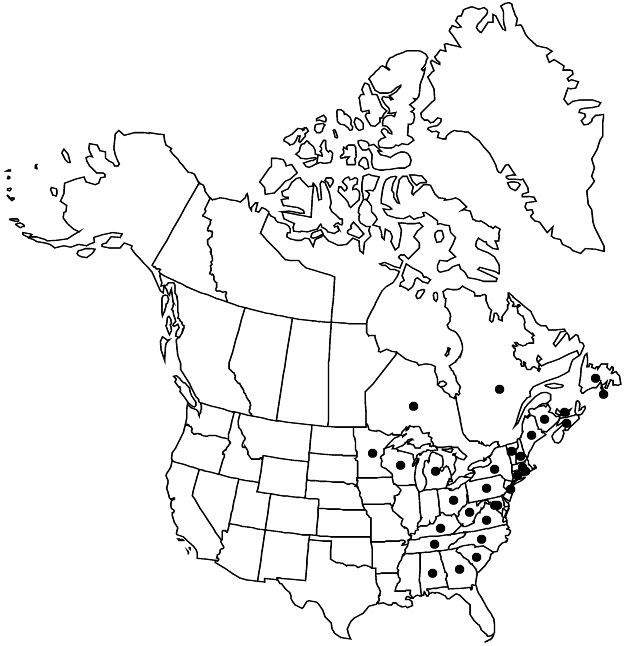Rubus canadensis
Sp. Pl. 1: 494. 1753.
Shrubs, 5–30 dm, unarmed or armed. Stems biennial, arching, glabrous, eglandular or sparsely sessile to short-stipitate-glandular, not pruinose; prickles absent or sparse, erect or slightly retrorse, slender, 2–5 mm, narrow to broad-based. Leaves deciduous, usually palmately compound, lustrous; stipules filiform to narrowly lanceolate, (5–) 8–15 (–22) mm; leaflets (3–) 5, terminal ovate to elliptic, (3–) 7–9 (–11) × (3–) 4–5 (–6) cm, base rounded to shallowly cordate, unlobed, margins finely to coarsely serrate or doubly serrate, apex acuminate to attenuate, abaxial surfaces sometimes with hooked prickles on midvein, glabrous or puberulent, eglandular. Inflorescences terminal on short-shoots, sometimes appearing axillary, (5–) 15–25-flowered, racemiform. Pedicels usually unarmed, hairy, eglandular or sparsely sessile to short-stipitate-glandular. Flowers bisexual; petals white, obovate to elliptic, 8–22 mm; filaments filiform; ovaries glabrous. Fruits black, globose to short-cylindric, 1–2 cm; drupelets 10–75, strongly coherent, separating with torus attached. 2n = 14, 21.
Phenology: Flowering May–Jul.
Habitat: Mountainous highlands, cool, shaded intermediate regions within deciduous and boreal forests, margins of lakes and woods
Elevation: 0–2000 m
Distribution

St. Pierre and Miquelon, N.B., Nfld. and Labr. (Nfld.), N.S., Ont., P.E.I., Que., Ala., Conn., D.C., Ga., Ky., Maine, Md., Mass., Mich., Minn., N.H., N.J., N.Y., N.C., Ohio, Pa., R.I., S.C., Tenn., Vt., Va., W.Va., Wis., in Europe (Poland)
Discussion
Rubus canadensis has a wide range and is the most northerly of all the highbush blackberries. The species is morphologically similar to R. allegheniensis except that the plants have little armature, are not as hairy, and have no glands. It also has characteristically lustrous leaves. The open and edge habitats in which it grows can greatly influence the phenotype, as with most highbush blackberries. At higher elevations or in poorer soil conditions, the plants are smaller; when partially shaded, leaves of primocanes may be larger. Leaves of floricanes vary in size and shape and are unreliable for identification. Because of the variation, multiple names have been erected, especially locally; it is felt that a stricter approach to defining it is prudent. Some of the names traditionally associated with sect. Canadenses (L. H. Bailey) L. H. Bailey are here associated with other Rubus species or are considered to refer to putative hybrids.
The following nothospecies names are based on putative hybrids involving Rubus canadensis and: R. allegheniensis (R. ×forestalis L. H. Bailey, R. ×immanis Ashe); R. flagellaris (R. ×lepagei L. H. Bailey, R. ×rixosus L. H. Bailey); R. hispidus (R. ×novanglicus L. H. Bailey); R. pensilvanicus (R. ×amabilis Blanchard [not Focke], R. ×amicalis Blanchard, R. ×elegantulus Blanchard [= R. canadensis var. elegantulus (Blanchard) Farwell], R. ×multilicius L. H. Bailey, R. ×noveboracus L. H. Bailey, R. ×pergratus Blanchard [= R. canadensis var. pergratus (Blanchard) L. H. Bailey], R. ×crux Ashe); R. setosus (R. ×miscix L. H. Bailey [based on R. ×peculiaris Blanchard (not R. peculiaris Sampaio)]).
Selected References
None.
Lower Taxa
"thin" is not a number."dm" is not declared as a valid unit of measurement for this property.